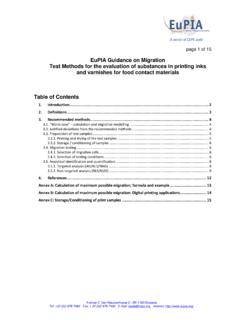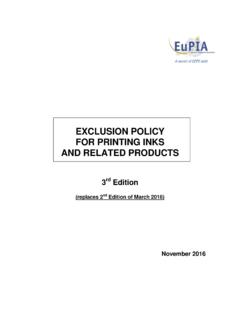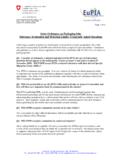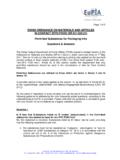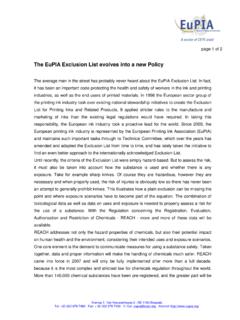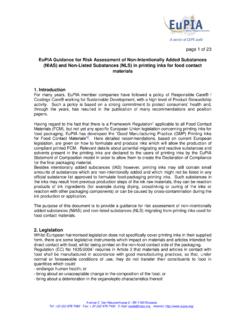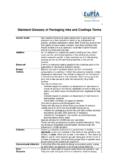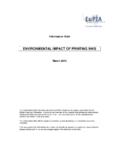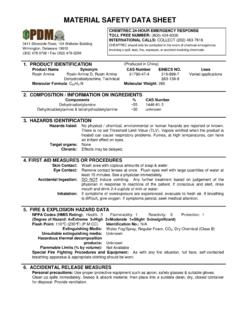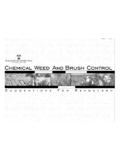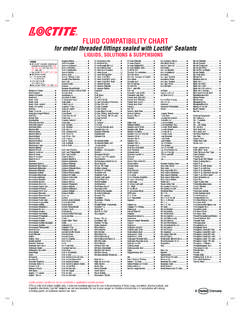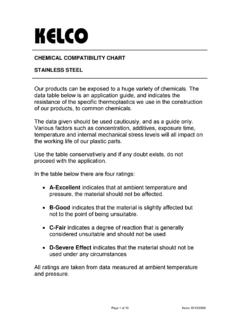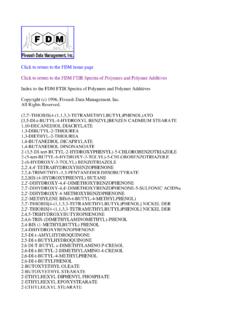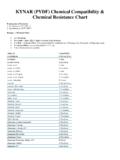Transcription of EuPIA European Printing Ink Association a sector of …
1 EuPIA . European Printing Ink Association a sector of CEPE aisbl INVENTORY LIST VERSION December 2013. COMPRISING PACKAGING INK RAW MATERIALS APPLIED TO THE NON-FOOD. CONTACT SURFACE OF FOOD PACKAGING. EuPIA Inventory List Notes & Lists 1. Preliminary note The EuPIA Guideline on Printing Inks Applied to the Non-Food Contact Surface of Food Packaging Materials and Articles has for many years included a scheme for the careful selection of raw materials to be used in the manufacture of food packaging inks. Nevertheless, in 2007 EuPIA decided to collate and make publicly available a list of all the substances used in the manufacture of food packaging inks, with the aim of implementing a transparent tool for packaging converters and brand owners. From 2007 to 2013 the list served with useful function, intending to be a reference for competent authorities and other stakeholders. At no time was the EuPIA Inventory List considered to be legally binding and served no specific regulatory function, thus could not assure compliance with European food contact material legislation.
2 The present legal situation in Europe is determined by single country legislation instead of harmonized legislation on a European scale. Since 2005, the Swiss Ordinance on Materials and Articles in contact with Food - SR (Swiss Consumer Goods Regulation) has been amended by the Swiss Federal Office of Public Health with provisions specific to food packaging inks. The core element of the regulation is a list of permitted substances identifying the only substances to be used in the manufacture of food packaging inks marketed in Switzerland. In Germany, the Federal Ministry for Food, Agriculture and Consumer Protection presented a draft ordinance amending the German Consumer Goods Ordinance ("German Ink Ordinance"). This amendment will contain a positive list of substances that can be used in Printing on food contact materials. Therefore, the consequence of having such listing in national regulations means that the EuPIA Inventory List had become superseeded by the evolution of legislation and was no longer relevant as an independent, updated document.
3 As a result, it was decided at the end of 2013 that the EuPIA Inventory List should be closed as a document, but would be maintained for the purposes of historical reference only within the EuPIA public website. Printing inks and varnishes for food packaging are intended to be applied to a variety of substrates using different Printing techniques, such as: Rotogravure and flexographic Printing on flexible films, Aluminium foil, paper and cardboard Offset Printing on paper, cardboard, rigid plastics and metal Screen Printing on rigid plastics, films, foil and metal Roller coating on metal Digital inks printed on paper, cardboard, flexible films and Aluminium foils Jet inks printed on paper, flexible films, Aluminium foils and rigid plastics Depending on the field of application and their formulation, Printing inks and varnishes have different drying mechanisms: Evaporation through hot air drying for water and solvent based systems Penetration into substrate structures with or without oxidative polymerisation Radical or cationic polymerisation induced by UV or EB irradiation.
4 High temperature drying by solvents evaporation and/or polymerisation using baking ovens. In the light of these diversified application requirements the strong chemical distinctions between ink systems and their constituent parts must be stressed. It should also be noted that the composition of the dried applied ink in almost all cases is not identical to the delivered wet' form. Furthermore it should also be noted that end-user and/or customer requirements may prevent the use of some of the materials below in certain applications. 2. Constituent parts of the Inventory List The Inventory List comprises of seven raw material groups used in the manufacture of food packaging inks and in addition a list of monomers and other precursors permitted to be used in the manufacture of plastic materials and articles in contact with food. The list of additives permitted to be used in the manufacture of plastic materials and articles in compliance with the legal constraints is included: Additives - chemical categories - ingredient substances Colorants, ( pigments, dyes).
5 Pigment additives Polymeric resins - generic groups - monomers/precursors/raw materials Solvents Enery Curing Monomers Photo-initiators List of monomers and other precursors permitted to be used in the manufacture of plastic materials and articles in contact with food, including additives permitted to be used in the manufacture of plastic materials and articles in contact with food. 3. Additional remarks Polymeric substances are described by their monomers and precursors. Polymerisation aids like catalysts and starters are not in the scope of the inventory list. Pigment preparations are broken back into their ingredients such as colorants, solvents, additives, dispersing aids and polymeric substances (their monomers). These substances are included in the respective substance groups. Additives, which are preparations, are broken back into their ingredients such as (wetting agents), solvents, waxes, plasticisers, polymeric substances (their monomers).
6 These substances are included in the respective substance group. Photo-initiators are included in a separate document " EuPIA Suitability List of Photo-initiators for Low Migration UV Printing Inks and Varnishes" (available at ). Substances may be covered by generic names where they have no CAS N and are covered by a group of substances. 4. Additives Additives are substances used normally in small quantities, which essentially impart specific technical properties to the Printing ink, primer or overprint varnish. Additive groups EuPIA has defined 19 groups of additives application, as shown below: (1) Acid catalyst (2) Adhesion promoter (3) Amine solubiliser (4) Antifoam agent (5) Antimist (6) Antistatic (7) Biocide (8) Chelating agent (9) Dispersing agent (10) Flow agent (11) Gellant (12) Ink stabiliser (13) Optical brightener (14) Photoinitiator (15) Slip agent (16) Suspension agent (17) Thickener (18) UV stabiliser (19) Wetting agent Additives are presented in two different lists: chemical categories of the substances and preparations used substances used as additives or ingredients of preparations Chemical Categories of Additives 1.
7 Chemically Defined Substances Alcohols Fatty alcohols Aminoalcohols Polyglycols Alkoxylated alcohols Acetylenic alcohols and derivatives Glycerol / Polyols Oxoalcohols, other alcohols Esters of Aliphatic alcohols Polyglycol esters Esters of alkoxylated alcohols Glycerolesters Trimethylolpropane esters Sorbitan esters Aminoalcohol Sulphonates Fatty alcohol esters Polyglycolether / Ether Acids Inorganic acids Organic acids Esters of Aromatic Acids Phthalates Benzoic acid esters and derivatives Aminobenzoic acid esters Benzenetricarboxylic acid esters Mellitates Trimellitic acid esters 1,4-Toluene Sulphonic acid esters / Benzene sulphonic acid ester Esters of Aliphatic- and Inorganic Acids Acetic acid esters Acrylic acid esters Adipic acid esters Citric acid esters Sebacic acid esters Phosphoric acid esters Phosphonic acid esters Sulphonic acid esters and derivatives Fatty Acids esters Isobutyric acid esters 2-Methylpropanoic acid ester Maleates Carbamic acid esters Formates Ketones 1-Hydroxycyclohexyl Phenylketone, other Alpha-Hydroxy Ketones, Ketosulphones Benzophenone and Derivatives 4-(2-Hydroxyethoxy)-phenyl(2-hydroxy-2-p ropyl)
8 -ketones Other Aliphatic Ketones Other Aromatic Ketones Phenolic Derivatives Alkylated Phenols Isononylphenol Derivatives Alkoxyphenols Alkylphenolalkoxylates Phenylphenols Hydroquinone and Derivatives Hydroquinone Alkylated Hydroquinones and Derivatives Quinines Inorganic Alkaline, Alkaline earth-, Zirconium, Zinc and Aluminium salts Carbonates Borates / Perborates Phosphates Polyphosphates Hydroxide gel, dried powder Hydroxy Ammonium Carbonates Hydroxides / Oxides Citrates Organic Alkaline, Alkaline earth-, Tin, Zinc, Zirconium, Barium and Aluminium salts Stearates / Laurates Nitro compounds / Phenylhydroxylamine complexes Al-Alkoxylates / Chelates and preparations Zr-Alkoxylates/Chelates Citrates Titanium Chelates Titanium Alkoxylates Titanium alkoxylated phosphates Titanium alcoholates Amides Fatty Acid Amides Fatty Acid Amide Derivatives Sulphoneamides Ammoniumsalts Inorganic Organic Alkaline-, Ammonia Hydroxides, salts (undissolved and dissolved in water).
9 Sodium Hydroxide Ammonium Hydroxide Potassium Hydroxide Potassium salts Benzoxazine and Benzoxazole / Triazole derivatives Benzoxazines derivatives Benzoxazol Thiophenediyl derivatives Benzotriazoles and Derivatives Cyclic Diazo Compounds Phosphine Oxide Derivatives Amines (optional preparations). Alkoxysilylated Amines Aminacrylates Amines (optional preparations). Fatty acid amines Alkoxylated amines Substituted Aromatic / Polycyclic Aromatic Hydrocarbons Oximes (Optional Preparations). (optional: Butoxy-2-propanol, refined paraffinics, fatty acid esters). Triazines / Stilbenes Silanes Phosphites Aldehydes 2. Polymeric Additives Polyaminoamides; optional salts dissolved in 2-Butoxyethanol Polyalkylene Polymers and Block Copolymers with pigment affinic groups Acetophenone- / Alkylamino- / Phenolic- / Urea- Formaldehyde resins Polyurethanes Polysiloxanes / Polydimethylsiloxanes / Cyclosiloxanes Polyether- / Aminosiloxanes Epoxides / Cycloaliphatic Derivatives Stabilisers Polyethers / Polyols Polyesters Polyacrylates Fluorinated acrylates Rosin (Abietic acid) based Fluoraliphatic Polymers Natural Polymeric Products Polymeric Aminobenzoates Polymeric Benzophenones Polymeric Thioxanthones Melamin-Formaldehyde resins 3.
10 Polymeric Additives Preparations Polyurethane, water based Polyurethane, solvent based Acrylic Polymers and Copolymers, water based Polyethers- / Polyvinylethers and Derivatives, water based Ethylene-Vinylacetate- / Polyvinyl based copolymers Polyfunctional aziridines, water based Acrylated Siloxanes / org. modified Siloxanes (water based included). Polyglycols and Derivatives Polyglycosides Polyoxyalkylenes, other Polymers, water based Imines Polyamides Hydrocarbons Chlorinated Polyolefinic preparations 4. Silicone- and Wax Preparations Silicone oil Emulsions, aqueous (silicone compound/s, optional: solvent, binder, glycol ethers, biocide). Silicone Preparation, non-aqueous (silicone compound/s, optional: solvent, binder). Organomodified Polysiloxanes, aqueous (silicone compound/s, optional: solvent, binder, biocide, solid silica). PE Wax Dispersions, aqueous (PE wax/es, water, optional: emulsifier, Silica, detergent, biocide). Oxidized PE wax/es, aqueous (wax/es, water, optional: emulsifier, detergent, biocide).


